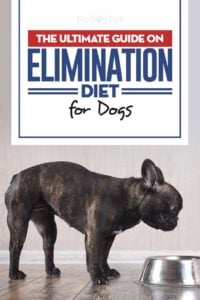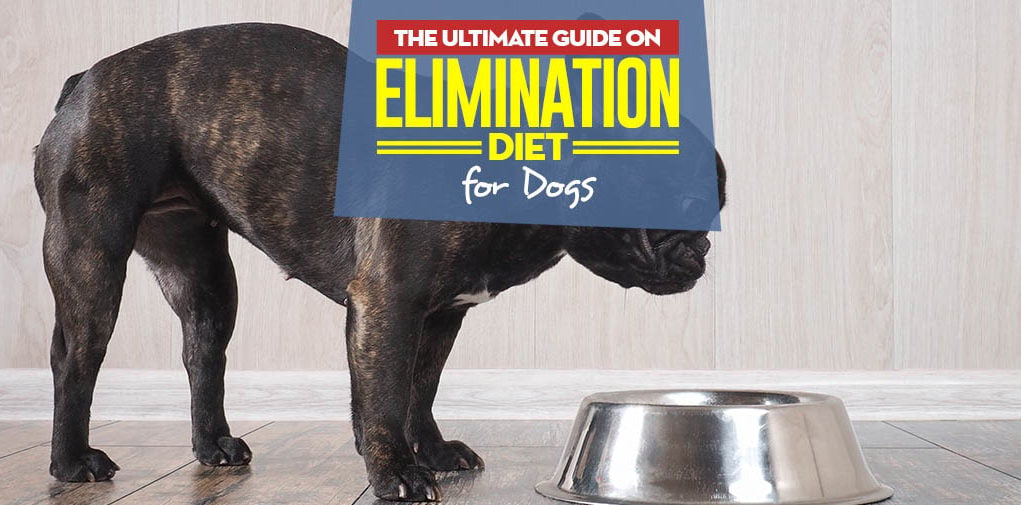The dog elimination diet is the most affordable – and, according to studies (1, 2, 3), the most reliable – approach to identifying and eliminating problem ingredients from your pet's diet.
If your dog has symptoms of food allergies or food sensitivities, your first priority needs to be finding out the source of the problem.
Table of Contents
- Dog Elimination Diet The ultimate science-based guide
- FAQs on Dog Elimination Diet
- Dog Elimination Diet: Final Thoughts
But what dog elimination diet really is, and how can a pet owner perform it at home? Are there any other alternatives to testing dogs for food allergies, and what would those cost?
Dog Elimination Diet: Doing Food Allergy Testing In Dogs
Allergy testing is a fast yet expensive method of identifying environmental, flea, and food allergies in dogs.
There are three popular ways (and one newly developed approach) to test a dog for food allergies (and others).
Besides the mentioned dog elimination diet, the other two are the skin prick test and blood sample test.
However, a dog elimination diet is the only one that can be done at home by pet owners themselves.
Skin test. This type of testing is done by exposing your dog to a specific allergen via a skin prick test and identifying the presence of a dermatological allergic reaction in the dog. This method of testing costs around $260 at a veterinary clinic.
Blood test. Allergy testing can also be done by taking a dog's blood sample to check for antigen-induced antibodies. This type of testing runs from $200 to $300 at the vet's office.
Although the two above-mentioned tests are accurate for a few specific allergies in dogs, they are expensive. They also aren’t always ideal for food allergy testing.
The inaccuracy of dog food allergy testing has caused the R&D of a new approach that tests your dog’s saliva for the presence of IgA and IgM antibodies.
While this type of testing can be more effective for identifying food allergies in dogs, it's still quite expensive, from $300 to $400 at the veterinary clinic.
Moreover, even when done alongside the dog elimination diet, it isn't always helpful (4).
Fortunately, if you are working on a minimal budget, the dog elimination diet is an affordable method of identifying your pet's allergens.
The disadvantage of this type of “testing” is that it takes a longer period of time to identify and eliminate culprit ingredients.
RECOMMENDED: How To Feed Dogs with Food Allergies
Dog Elimination Diet
The ultimate science-based guide
Dog Elimination Diet: Effectiveness and Duration
The dog elimination diet involves gradually shifting your pet to a diet that has none of the more common allergen proteins and carbohydrates, such as beef or dairy (5).
After this shift, you can start with a “blank slate.” You will then begin to add eliminated ingredients back into your dog’s diet and take note of any changes in his health.
95% of the time, this slow but effective process will allow you to pinpoint exactly what ingredients your dog is sensitive to.
Using a sample of 209 canines with adverse food reactions, researchers have studied the dog elimination diet for its effectiveness.
The duration it takes for pets to “get better” while on this diet was also observed.
Here are the results (6):
- After 3 weeks – 50% of dogs showed no food allergy signs
- After 5 weeks – 85% of dogs showed no food allergy signs
- After 8 weeks – over 95% of dogs showed no food allergy signs
Less than 5% of canines will need to do the dog elimination diet for up to 13 weeks.

In conclusion, scientists recommend that in at least 80% of cases, the restrictive (elimination) diet trial should be done for at least 5 weeks.
Other studies (7) recommend 10 weeks for more serious cases.
Increasing the duration of the dog elimination diet up to 8 weeks will increase the sensitivity of diagnosis to more than 90% of cases.
If your dog falls into the 5% that has an unusual or hard-to-identify food allergy, and the dog elimination diet is unsuccessful, you will want to consider one of the allergy testing methods noted above.
Remember, you should always speak with your veterinarian before making the decision to put your pet on a dog elimination diet.
When to Try the Dog Elimination Diet
Many symptoms can indicate your dog's food allergy (8, 9, 10, 11). These include:
- hair loss
- itching
- raw red skin
- infection of the skin
- chewing on the feet
- constant licking of the feet
- chronic ear infections
These symptoms are broader symptoms of an allergic reaction, but when your dog experiences food allergies, you may also notice the following:
- diarrhea
- vomiting
- excess gas
- abdominal pain
- serious allergies may also cause symptoms of anaphylaxis
These symptoms can also be indicative of other health conditions.
It’s always best to consult your veterinarian to eliminate any other possible causes before assuming that food allergies are to blame and starting with the dog elimination diet trial.
RELATED: Allergy Meds for Dogs – When Does Your Dog Need Them?
Two Types of Dog Elimination Diet Trials
There are two types of dog elimination diet approaches:
- Prescription food dietary trial. This approach involves switching your dog to store-bought prescription dry kibble or wet food that eliminates major food allergens.
- Homemade dog elimination diet. This one involves structuring your own homemade dog food diet and monitoring ingredients by yourself.
Both approaches have their pros and cons. Depending on your situation and your dog's food allergy type, one might be better than the other.
Prescription Dog Food Trial
This is an easier and more convenient way to carry out the elimination dietary trial.
However, these commercial dog foods often come from companies that don't have the best reputation and are often blamed by pet owners for other health issues in dogs.
Not all prescription dog food brands are bad, though.
Some actually have great reputations but are only working for a specific subset of dog food allergy cases.
There are also things that pet owners must know about prescription foods.
The major downsides are that they may have repeated dog food recalls, include ingredients that are questionably sourced, include filler ingredients, require a veterinary prescription, or be extremely expensive.
Moreover, 2017 studies (13, 14) have found that these elimination diet dog foods with novel proteins, hydrolyzed protein, and single-ingredient formulas are not always effective for diagnosing food allergies in dogs.
If you choose to do this diet with your dog, make sure that you research the company that produces that food and the ingredients in it.
Just because the dog food has to be purchased with a prescription or is recommended by a veterinarian does not mean it is a healthy, safe choice.
Homemade Dog Elimination Diet
 The second method of carrying out the dog elimination diet is via a homemade diet.
The second method of carrying out the dog elimination diet is via a homemade diet.
Homemade dog elimination diet is preferred by the majority of pet owners willing to put in a little work.
This involves feeding your dog food that you cook at home like you would for yourself. Only two basic ingredients are needed here – a protein source and a carbohydrate source.
If you go this route, make sure to check a number of homemade dog food recipes to try.
You also have to filter out those with ingredients that can potentially cause an allergic reaction in your dog.
Studies show (15; PDF) that the most common protein allergens include:
- Beef
- Chicken
- Egg
- Soy
- Lamb
And the most common carbohydrate allergens include:
- Wheat
- Corn
- Potatoes
Other common allergens include yeast and dairy products (16).
But of course, your dog could also be allergic to virtually any ingredient in his diet (17).
It's important that you follow a strict dog elimination diet in order to find out exactly which ingredient is causing the problem.
ASK A VET: Does Hypoallergenic Dog Food Really Work, and Why?
Before Beginning the Elimination Diet
Preparation, routine, and strictly adhering to the rules of the dog elimination diet will likely result in success (remember, you have a 95% chance).
Make a list of your dog’s foods that they have been eating since showing allergy symptoms.
Look at the ingredients in those dog foods, paying the most attention to protein and carbohydrate sources. These are the ingredients that are most likely to be causing your dog’s allergies.
Here are a few things that you have to keep in mind to increase the likelihood of success:
(1) Elimination diets contain much fewer additives and fillers, so you will likely notice that your dog goes to the bathroom less during their elimination diet period.
(2) The dog elimination diet has more moisture than traditional dog foods, so if you notice your dog drinking less than normal, this is likely why.
(3) When feeding the home-cooked dog elimination diet, divide the meal 50/50 between a single carbohydrate and a single protein.
(4) Changing your dog to the elimination diet too quickly may result in gastrointestinal-related issues and tummy upset. Change it slowly.
(5) A homemade elimination diet is quite bland, and picky dogs may be reluctant to eat. Stick with the elimination diet for a few days; your pet should come around.
(6) Don’t feed your dog treats, table scraps, bones/chews, vitamins/supplements, or edible medications (like heartworm treatment) during the dog elimination diet. If your Fido is due for edible medication during its elimination period, talk to your vet about possible alternatives.
Starting the Dog Elimination Diet
During the elimination diet, you will feed your pooch either a prescription elimination food or home-cooked food, depending on your chosen approach.
Ask your vet about his prescribed dog food brand and formula/recipe option for your individual dog.
If you are going to use the home-cooked food approach, choose the protein and carbohydrate that you want to begin feeding.
Choose ingredients that do not feature on the ingredient list of your dog’s previous foods.
Protein sources to consider for your homemade dog elimination diet trial include:
- venison
- bison
- buffalo
- emu
- fish
- pheasant
- ostrich
- kangaroo
- duck
- turkey
- rabbit
- pork
Carbohydrate sources that you may consider:
- brown rice
- pearled Barley
- pumpkin
- oats
- sweet potatoes
- squash
When choosing ingredients to include in your dog's homemade meals, remember that it’s best to choose ingredients that are not closely related to possible allergens.
For example, if your dog has been eating chicken and has allergy symptoms, don’t go straight to using duck in your dog elimination diet. Instead, choose something that is less likely to cause a reaction, like venison.
When home-cooking your dog’s food, you are aiming for basic meals.
Your protein and carbohydrate sources should never include seasoning or additives. Your protein should also be trimmed and skimmed of fat.
It needs to be cooked in a way that reduces the fat content. For example, bake, boil, or broil your meat – never skillet-cook it.
To portion your dog’s food, begin by using calories as a reference.
For example, if your dog eats 600 calories daily in their kibble, you want to closely replicate that number with your home-cooked meals.
If you notice any weight loss or unusual signs of hunger, increase the amount of food you are giving your dog daily.
Likewise, if you notice weight gain, cut back on your dog’s food slightly.
RECOMMENDED: 10 Popular Homemade Dog Food Recipe Videos
The Shift Must Be Gradual
As with any shift in your dog’s diet, it’s important to move them onto the dog elimination diet gradually.
While the intent of the diet is to relieve allergen symptoms, a shift in diet that happens too quickly can cause additional symptoms of gastric upset in pets.
The recommended schedule for shifting your dog to a new diet is as follows:
- Days 1 – 3: ¼ new diet and ¾ old diet
- Days 4 – 7: ½ new diet and ½ old diet
- Days 8 – 11: ¾ new diet and ¼ old diet
- Day 12: 100% new diet
Once you have your dog on the elimination diet, it’s important to maintain that diet for a minimum of 5-10 weeks.
You may be tempted to stop the elimination diet if your dog’s symptoms resolve or if Fido shows resistance to his new diet. However, do not stop before the minimum number of weeks.
Stick with the diet for the recommended time period so that you can effectively identify the allergens.
After starting your pooch on the complete dog elimination diet, you should begin seeing his allergy symptoms lessen over the first three to six weeks (18).
If your dog shows no improvement in his allergy symptoms, begin the elimination diet again with alternate protein and carbohydrate sources.
Keep Detailed Notes
 While your dog is on their elimination diet, it’s crucial that you keep detailed notes.
While your dog is on their elimination diet, it’s crucial that you keep detailed notes.
These notes should identify the protein and carbohydrate source your dog is eating during that time and note any symptom changes or new developments.
The more detailed your notes during this period, the better you will be able to track your dog’s progress and reaction to specific allergens.
These notes can also be very beneficial when meeting your veterinarian or a canine nutritionist.
Begin Reintroducing Ingredients
After 5-10 weeks, your dog should be like a “blank slate” if the diet has worked to significantly reduce or eliminate allergy symptoms.
Once you reach this “blank slate” status, you want to begin reintroducing foods one at a time to determine whether or not they cause symptoms to recur.
When reintroducing foods to your dog’s diet, stick with more novel protein and carbohydrate sources to allow your dog time to react (19).
For example, you may have been feeding venison and sweet potato and seeing great improvement. Try adding a small amount of bison into your dog’s diet for variety, and keep this up for a few weeks at a minimum.
Make sure to keep up your diary of symptoms to track any changes in your dog’s health.
As you reintroduce ingredients, you may choose to stay away from reintroducing common allergens.
You can do this by sticking with home-cooked food or choosing a limited-ingredient dog food that mimics what your dog has been eating on the elimination diet.
If you notice any signs of allergy symptoms returning after reintroducing a specific ingredient to your dog’s diet, eliminate that ingredient immediately and take note in your symptom diary.
Take your dog back to the elimination diet ingredients that did not cause any reaction and allow them a few days to return to their baseline point (the “blank slate”).
After this, you want to try reintroducing another (different) ingredient to your dog’s diet that is not closely related to problematic ingredients.
Identify a Food That Suits Your Dog
Once you have reintroduced a variety of foods back into your dog’s diet, you can begin looking at commercial dog food brands if you choose so.
Just make sure to stick with limited-ingredient foods at first, and choose foods that mimic the safe ingredients from your elimination diet trial.
If you notice a recurrence of symptoms in your dog, analyze the ingredients of the food that they have been eating.
Try to identify which ingredient is the culprit and go back to the dog elimination diet that he was eating previously to allow his digestive system time to heal.
Don’t be afraid to try again with a different food option after an adequate break.
If you decide to stick with homemade dog food meals, it’s important that you consult your vet about providing your dog with adequate nutrition.
Cooking for dogs can be tricky, and you need to know about supplements, dog nutrition, serving size and more.
FAQs on Dog Elimination Diet
How can I tell if my dog is allergic to his food?
The most common sign that your dog is allergic to his food is itching.
You will notice your dog scratching or licking their paws, sides, rear, and other body parts if they're getting allergic reactions from his food.
What meats are dogs least allergic to?
The meats that are probably the safest for your allergic dog are:
- Venison
- Rabbit
- Duck
- Kangaroo
- Bison
What human food can I feed my dogs with allergies?
Apart from the meats mentioned above, you can also try feeding your allergic dog other human food like broccoli, green beans, apples, pears, and watermelons.
Dog Elimination Diet: Final Thoughts
The dog elimination diet is very basic and cannot provide your dog with all of the vitamins and minerals that they need in the long term.
Overall, home-cooking your dog’s meals is perfectly safe; it simply requires the addition of specific supplements that are catered to your dog’s needs and more time and effort on your part.
Is your veterinarian clueless when it comes to home cooking and canine nutrition? Don’t panic; consult a canine nutritionist instead.
READ NEXT: The Veterinarian's Guide to Shopping for Hypoallergenic Dog Foods















